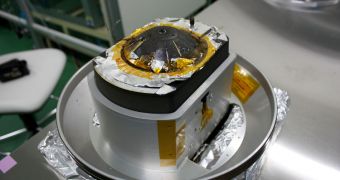Experts at JAXA announced that they have recovered a series of small particles from the sample chamber of the battered Hayabusa mission, which returned to Earth this June.
They say that some of these small particles, which are invisible to the naked eye, may very well be extraterrestrial dust. If so, then the mission was completely worth it.
The Japan Aerospace Exploration Agency (JAXA) has been taking care of the damaged Hayabusa space probe for nearly seven years, before its sample container was finally ejected back to Earth a few months ago.
This was a momentous occasion for the space agency, and for humankind's goals of space exploration, as it represented the first time a sample-return mission to a near-Earth object (NEO) was successful.
Due to some mishaps that took place as Hayabusa was meeting up with its target, asteroid Itokawa, the spacecraft was unable to collect dust samples from the space rock in the manner originally intended.
However, JAXA experts said that the sample chamber could have collected some dust particles regardless, and decided to try and bring the probe home in either case.
After the sample capsule reentered Earth's atmosphere, and landed in the Australian Outback, Japanese researchers retrieved it, and began investigating its content. A few fine particles is all they found.
Originally, of these particles, most were believed to be debris, that made it into the chamber when Hayabusa was assembled in Japan, so many years ado.
Of the “catch” the orbiter brought one, researchers say that 100 fine particles were discovered in the sample catcher, the portion of the sample chamber that was supposed to contain the cosmic dust.
The investigations team says that these particles are smaller than 0,001 millimeters in size, and hypothesize that some of them might very well be extraterrestrial dust.
Scientists opened the container in the most sterile conditions possible, and used a special Teflon spatula to collect the fine particles. The grains are invisible to the unaided eye
The spatula that helped JAXA experts collect the contents of the sample catcher was about 6 millimeters long and 3 millimeters wide, and was designed specifically for this purpose.
Now, JAXA plans to conduct additional studies into the structure of the recovered particles. Studies will be carried out at the large-scale synchrotron radiation facility called Spring 8, in the Hyogo Prefecture.
“We cannot yet tell (whether the particles are from Itokawa) from their external features, but we have found many particles and there is a chance (that they are extraterrestrial),” explains Munetaka Ueno.
The expert is a research scientist at the JAXA Institute of Space and Astronautical Science. He adds that alien dust could give us a better understanding of how the solar system formed, The Mainichi Daily News reports.

 14 DAY TRIAL //
14 DAY TRIAL //